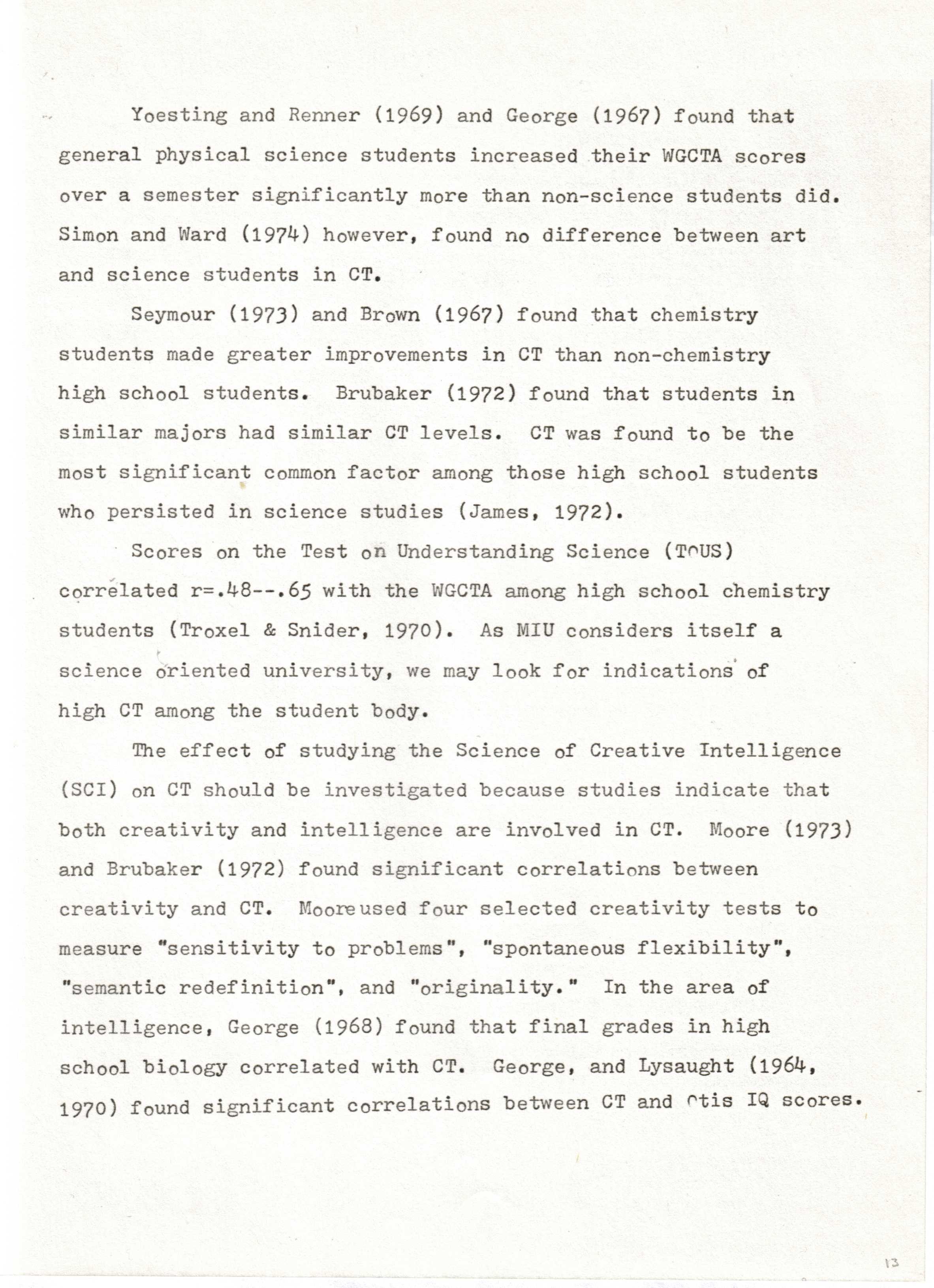
ctomeegmiu13.jpg
|
Yoesting and Renner (1969) and George
(1967) found that
general physical science students increased
their WGCTA scores
over a semester significantly more than
non-science students did. Simon and Ward (197U) however, found no
difference between art
and science students in CT.
Seymour (1973) and Brown (1967) found that
chemistry
students made greater improvements in CT
than non-chemistry
high school students. Brubaker (1972) found
that students in
similar majors had similar CT levels. CT
was found to be the
most significant common factor among those
high school students
who persisted in science studies (James,
1972).
Scores on the Test on Understanding Science
(TFUS)
correlated r=.48--.65 with the WGCTA among
high school chemistry
students (Troxel & Snider, 1970). As MIU
considers itself a
science oriented university, we may look
for indications of
high CT among the student body.
The effect of studying the Science of
Creative Intelligence
(SCI) on CT should be investigated because
studies indicate that
both creativity and intelligence are
involved in CT. Moore (1973)
and Brubaker (1972) found significant
correlations between
creativity and CT. Moore used four selected
creativity tests to
measure 'sensitivity to problems",
"spontaneous flexibility',
"semantic redefinition", and "originality."
In the area of
intelligence, George (1968) found that
final grades in high
school biology correlated with CT. George,
and Lysaught (1964,
1970) found significant correlations
between CT and Otis IQ scores. |
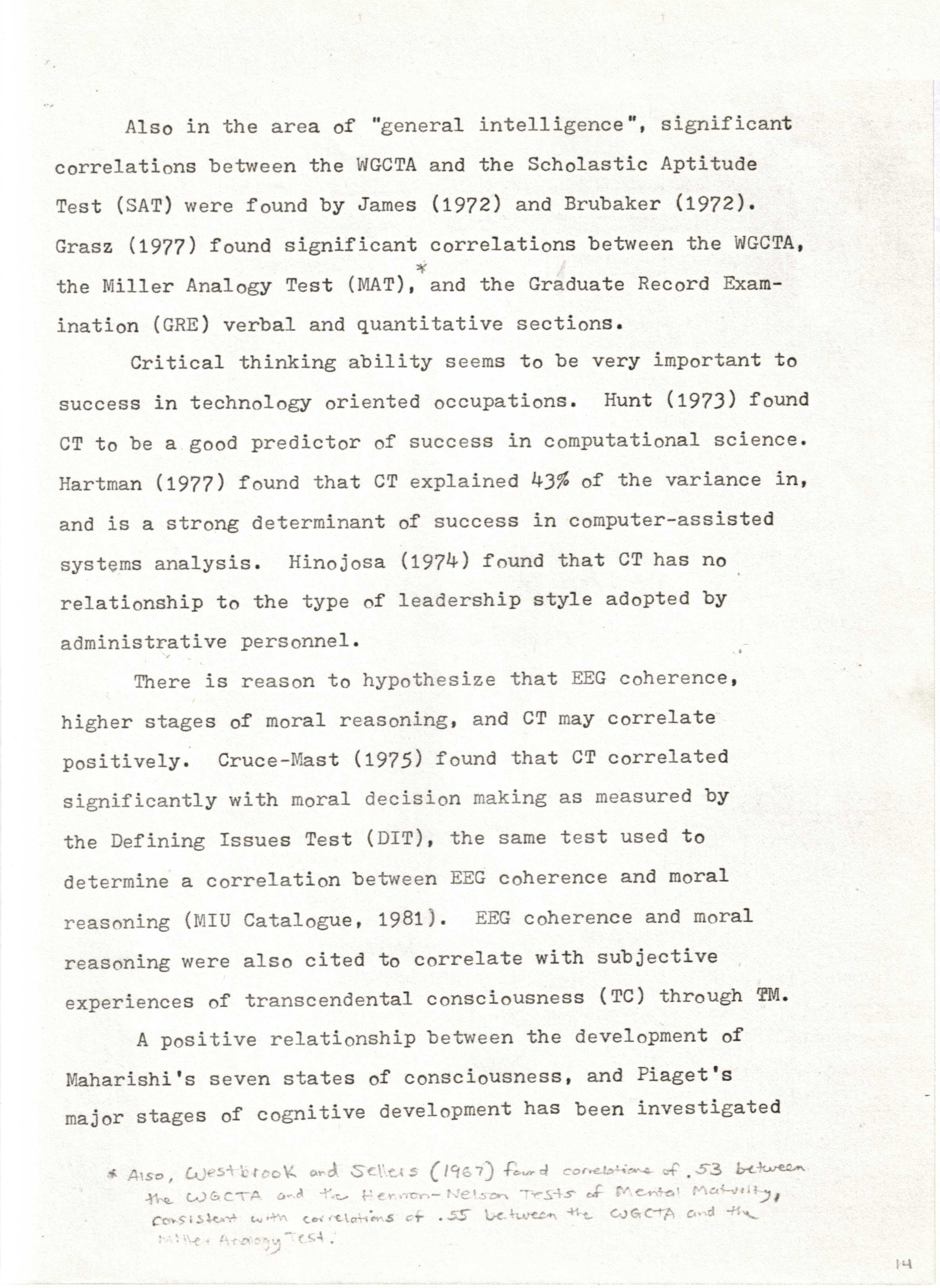
ctomeegmiu14.jpg
|
Also in the area of ”general intelligence",
significant correlations between the WGCTA and the Scholastic Aptitude Test
(SAT) were found by James (1972) and Brubaker (1972). Grasz (1977) found
significant correlations between the WGCTA, the Miller Analogy Test (MAT), and
the Graduate Record Examination (GRE) verbal and quantitative
sections.
Westbook and Sellers (1967) found correlations of .53
between the WGCTA and the Hennen-Nelson Tests of Mental Maturity, consistent
with correlations of .55 between the WGCTA and the Miller Analogy Test (MAT).
Critical thinking ability seems to be very important
to success in technology oriented occupations. Hunt (1973) found CT to be
a good predictor of success in computational science. Hartman (1977) found
that CT explained 43% of the variance in, and is a strong determinant of success
in computer-assisted systems analysis. Hinojosa (1974) found
that CT has no relationship to the type of leadership style adopted by
administrative personnel.
There is reason to hypothesize that EEG coherence,
higher stages of moral reasoning, and CT may correlate positively. Cruce-Mast
(1975) found that CT correlated significantly with moral decision making as
measured by the Defining Issues Test (DIT), the same test used to
determine a correlation between EEG coherence and moral reasoning (MIU
Catalogue, 1981). EEG coherence and moral reasoning were also cited to correlate
with subjective experiences of transcendental consciousness (TC) through TM.
A positive relationship between the development of
Maharishi‘s seven states of consciousness, and Piaget's major stages of
cognitive development has been investigated |
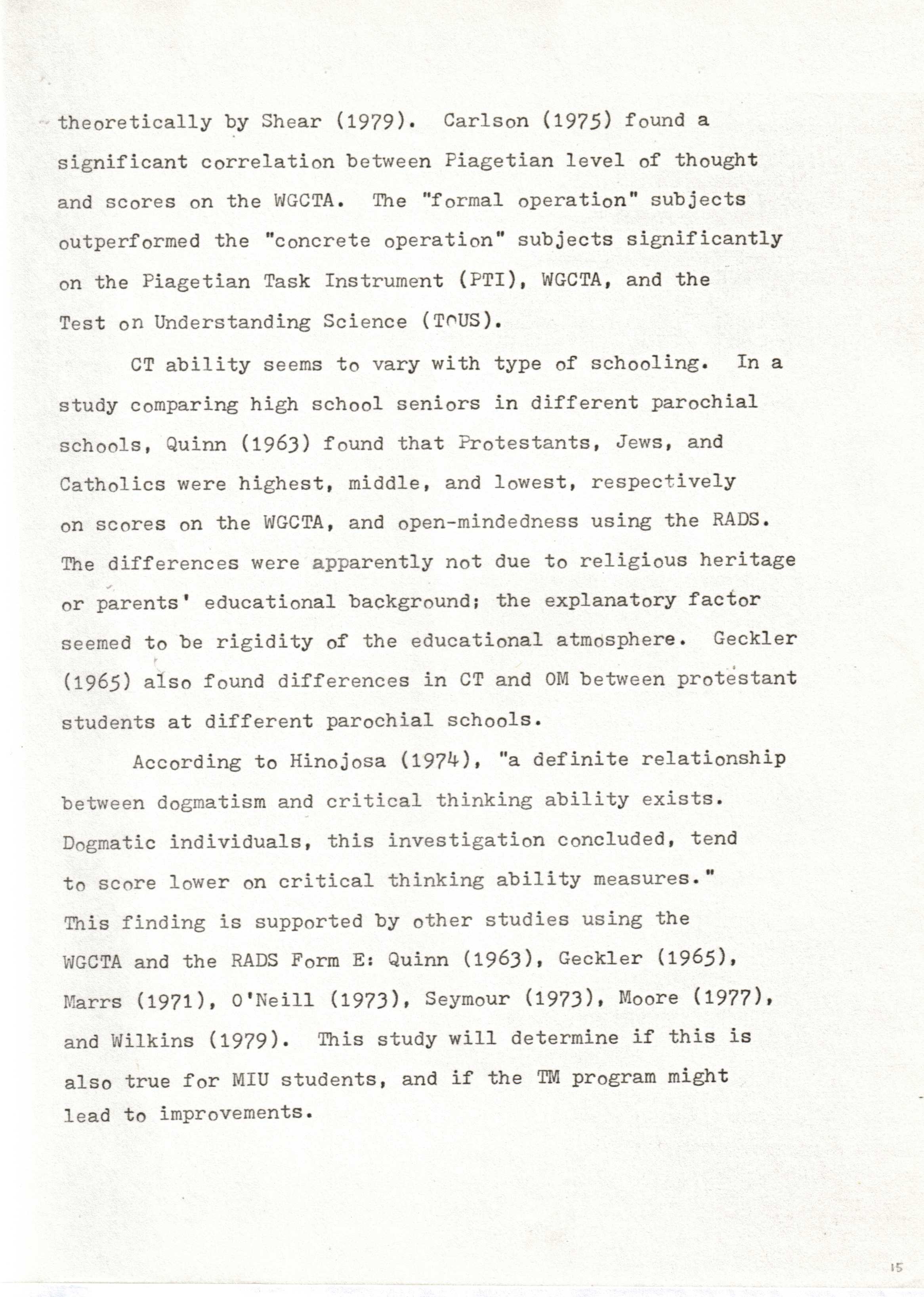
ctomeegmiu15.jpg
|
theoretically by Shear (1979). Carlson (1975) found a significant correlation
between Piagetian level of thought and scores on the WGCTA. The "formal
operation" subjects outperformed the "concrete operation" subjects significantly
on the Piagetian Task Instrument (PTI), WGCTA, and the Test on Understanding
Science (TFUS).
CT ability seems to vary with type of
schooling. In a study comparing high school seniors in different parochial
schools, Quinn (1963) found that Protestants, Jews, and Catholics were highest,
middle, and lowest, respectively on scores on the WGCTA, and open-mindedness
using the RADS. The differences were apparently not due to religious
heritage or parents' educational background; the explanatory factor seemed to be
rigidity of the educational atmosphere. Geckler (1965) also found differences in
CT and OM between protestant students at different parochial schools.
According to Hinojosa (1974), "a definite
relationship between dogmatism and critical thinking ability exists. Dogmatic
individuals, this investigation concluded, tend to score lower on critical
thinking ability measures." This finding is supported by other studies
using the WGCTA and the RADS Form E: Quinn (1963), Geckler (1965), Marrs (1971),
O'Neill (1973), Seymour (1973). Moore (1977), and Wilkins (1979). This study
will determine if this is
also true for MIU students, and if the TM program might lead to improvements. |
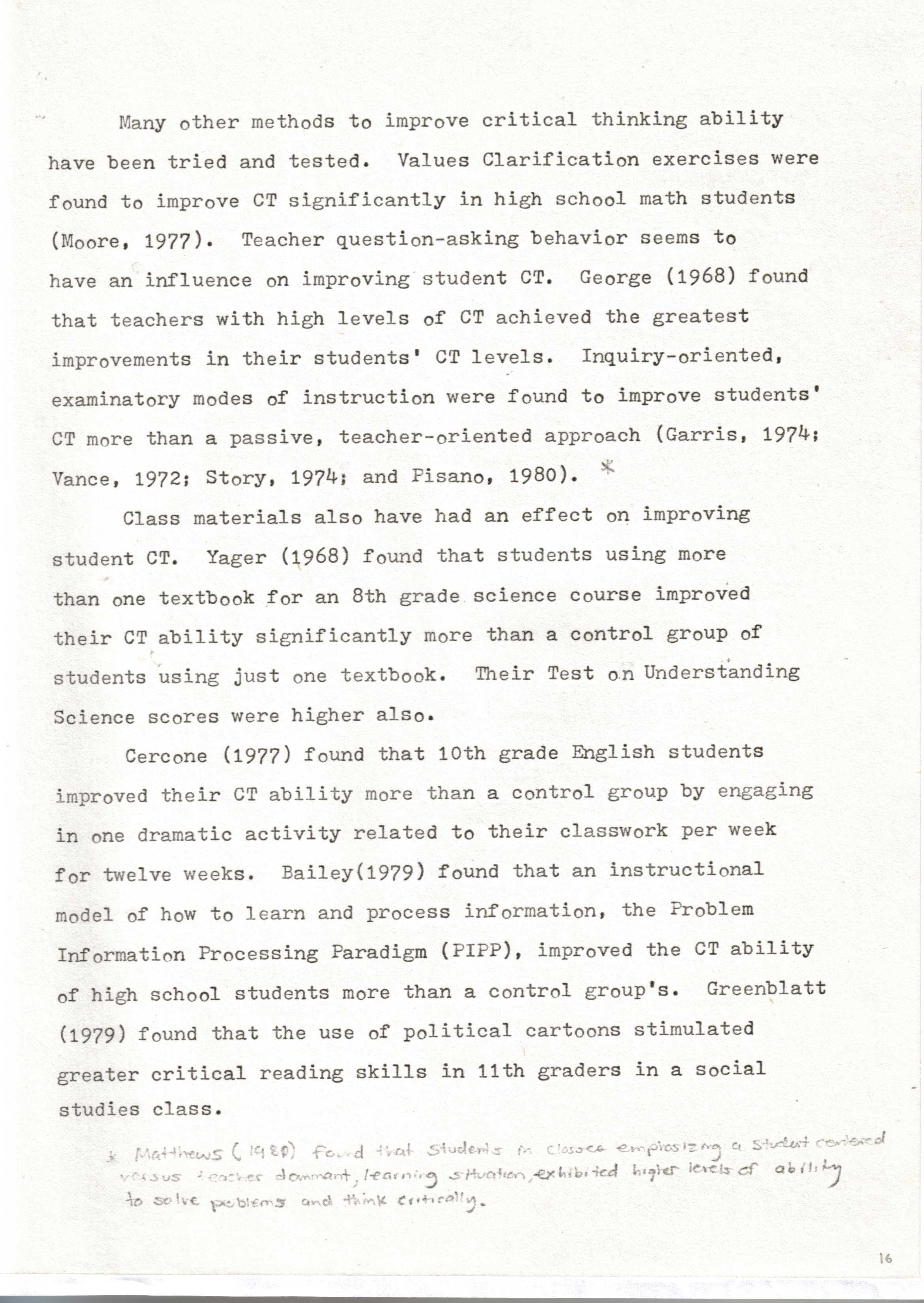
ctomeegmiu16.jpg
|
Many other methods to improve critical thinking
ability have been tried and tested. Values Clarification exercises were
found to improve CT significantly in high school math students (Moore, 1977).
Teacher question-asking behavior seems to have an influence on improving student
CT. George (1968) found that teachers with high levels of CT achieved the
greatest improvements in their students’ CT levels, Inquiry-oriented,
examinatory modes of instruction were found to improve students' CT more than a
passive, teacher-oriented approach (Garris, 1974; Vance, 1972: Story, 197M; and
Pisano. 1980).
Class materials also have had an effect on improving
student CT. Yager (1968) found that students using more than one textbook for an
8th grade science course improved their CT ability significantly more than a
control group of students using just one textbook. Their Test on Understanding
Science scores were higher also.
Cercone (1977) found that 10th grade English students
improved their CT ability more than a control group by engaging in one dramatic
activity related to their class work per week for twelve weeks. Bailey (l9?9)
found that an instructional model of how to learn and process information, the
Problem Information Processing Paradigm (PIPP),
improved the CT ability of high school students more than a control
group's. Greenblatt (1979) found that the use of political cartoons stimulated
greater critical reading skills in 11th graders in a social
studies class.
Matthews (1980) found that students in classes
emphasizing a student centered, versus teacher dominant, learning situation
exhibited higher levels of ability to solve problems and think critically.
|
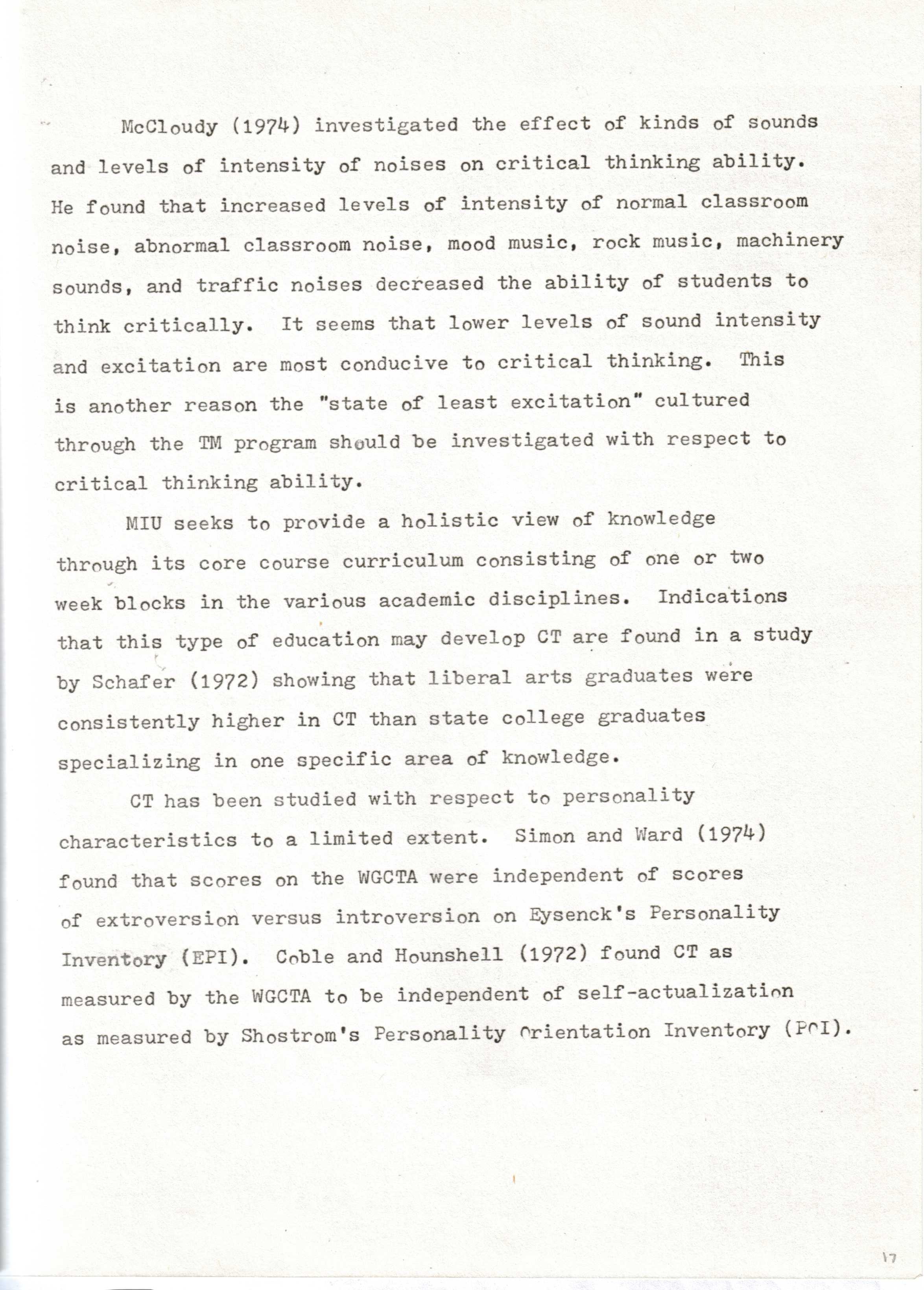
ctomeegmiu17.jpg
|
McCloudy (1974) investigated the effect of kinds of
sounds and levels of intensity of noises on critical thinking ability. He found
that increased levels of intensity of normal classroom
noise, abnormal classroom noise, mood music, rock music, machinery sounds, and
traffic noises decreased the ability of students to think critically. It seems
that lower levels of sound intensity and excitation are most conducive to
critical thinking. This is another reason the ”state of least excitation'
cultured ; through the TM program should be investigated with respect to
critical thinking ability.
MIU seeks to provide a holistic view of knowledge
through its core course curriculum
consisting of one or two week blocks in the various academic disciplines.
Indications
that this type of education may develop CT are found in a study by Schafer
(1972) showing that liberal arts graduates more - consistently higher in CT than
state college graduates
specializing in one specific area of knowledge.
CT has been studied with respect to personality
characteristics to a limited extent. Simon
and Ward (197U) found that scores on the WGCTA were independent of scores
of extroversion versus introversion on Eysenck's Personality Inventory (EPI).
Goble and Hounshell (1972) found CT as measured by the WGCTA to be independent
of self-actualization as measured by Shostrom's Personality Orientation
Inventory (PPI). |
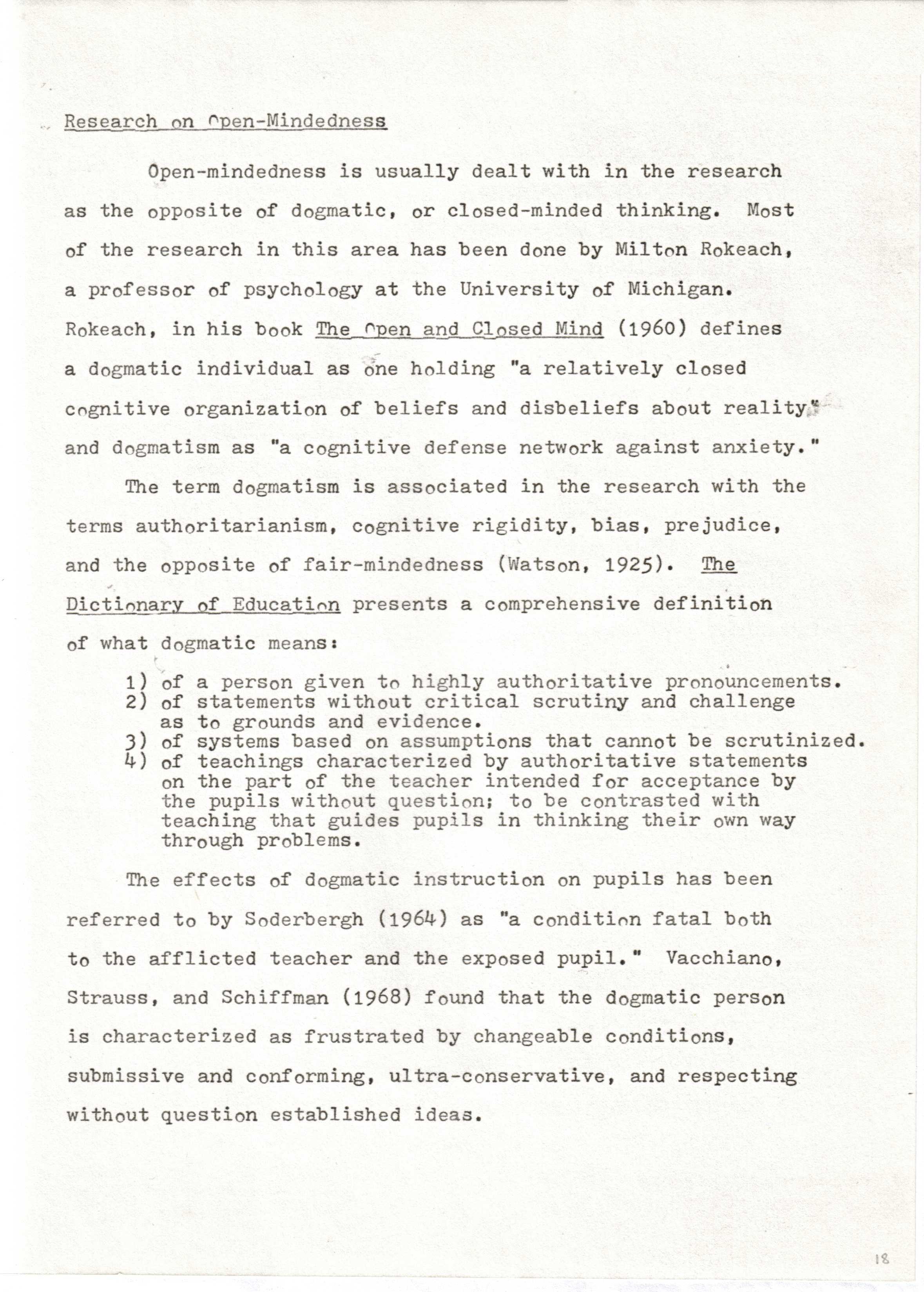
ctomeegmiu18.jpg
|
Research on Open-Mindedness 0pen-mindedness is
usually dealt with in the research as the opposite of dogmatic, or closed-minded
thinking. Most of the research in this area has been done by Milton Rokeach, a
professor of psychology at the University of Michigan. Rokeach, in his
book The Open and Closed Mind (1960) defines a dogmatic individual as one
holding ”a relatively closed cognitive organization of beliefs and disbeliefs
about reality
and dogmatism as ”a cognitive defense network against anxiety.”
The term dogmatism is associated in the research with
the terms authoritarianism. cognitive rigidity, bias. prejudice, and the
opposite of fair-mindedness (Watson. 1925). The Dictionary of Educating presents
a comprehensive definition of what dogmatic means:
1) of a person given to highly authoritative pronouncements.
2) of statements without critical scrutiny and challenge as to grounds and
evidence.
3) of systems based on assumptions that cannot be scrutinized.
4) of teachings characterized by authoritative statements on the part of the
teacher intended for acceptance by the pupils without question: to be contrasted
with teaching that guides pupils in thinking their own way through problems.
The effects of dogmatic instruction on pupils
has been referred to by Soderbergh (1964) as "a condition fatal both to the
afflicted teacher and the exposed pupil.” Vacchiano, Strauss, and Schiffman
(1968) found that the dogmatic person is characterized as frustrated by
changeable conditions, submissive and conforming, ultra-conservative, and
respecting without question established ideas. |